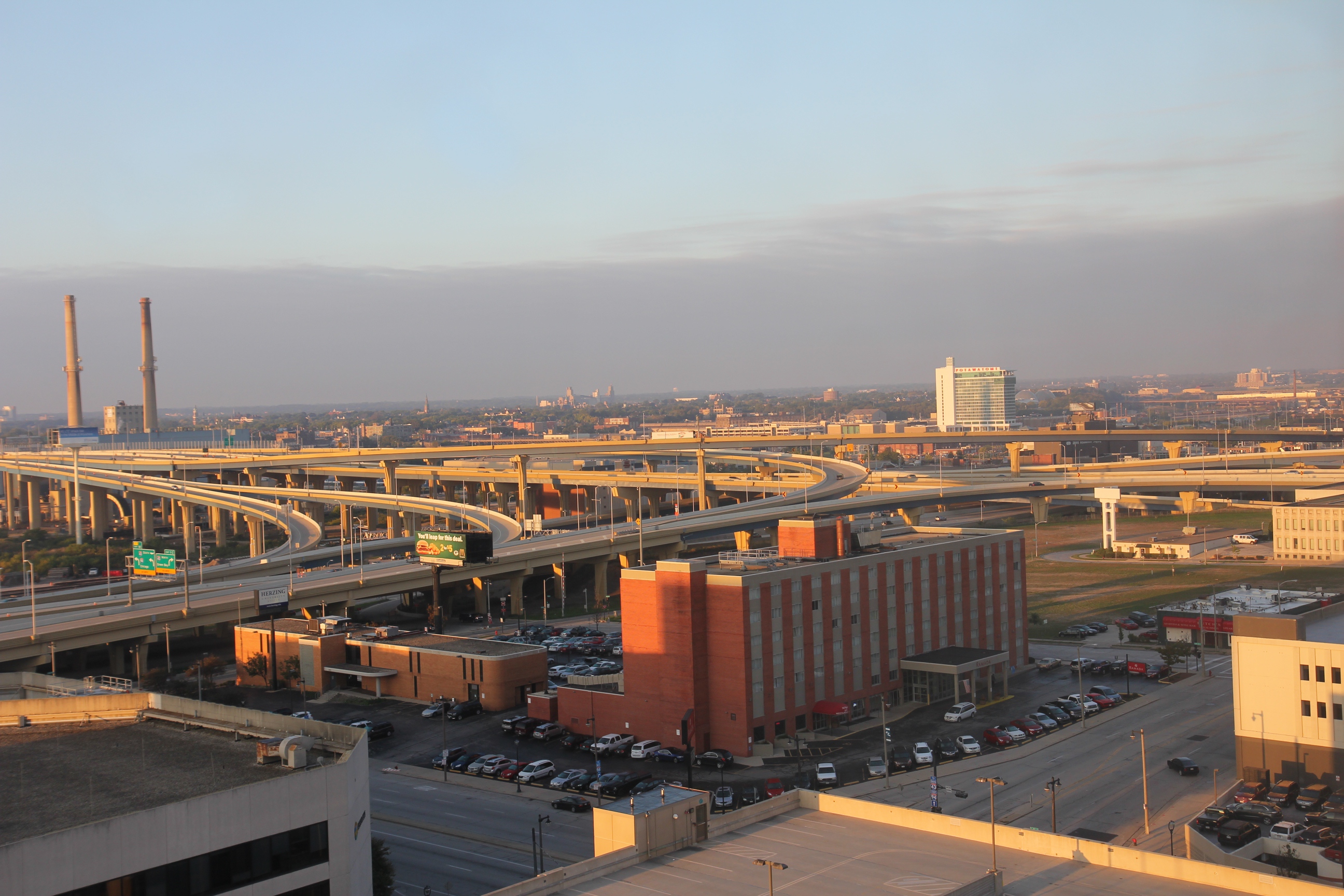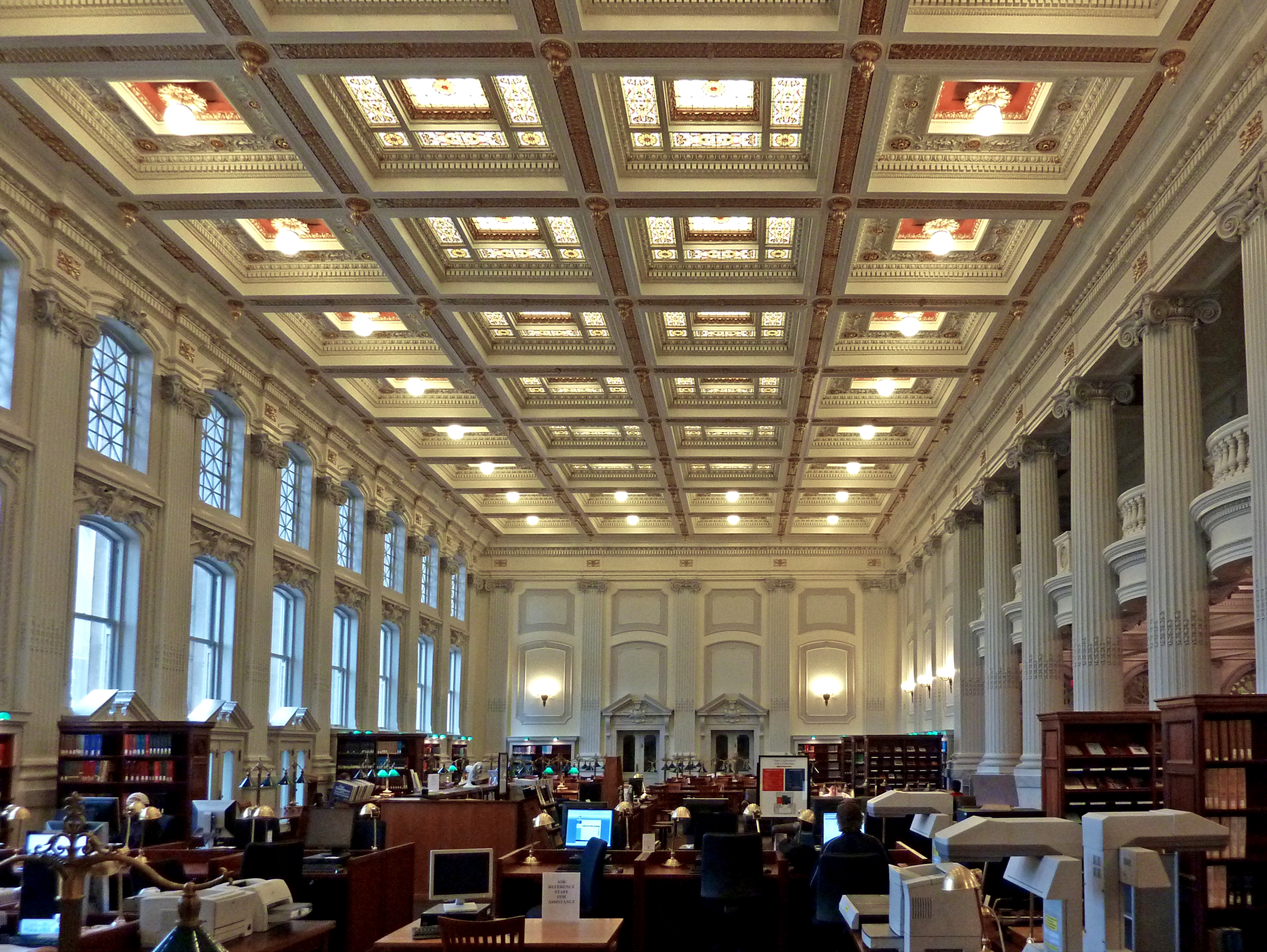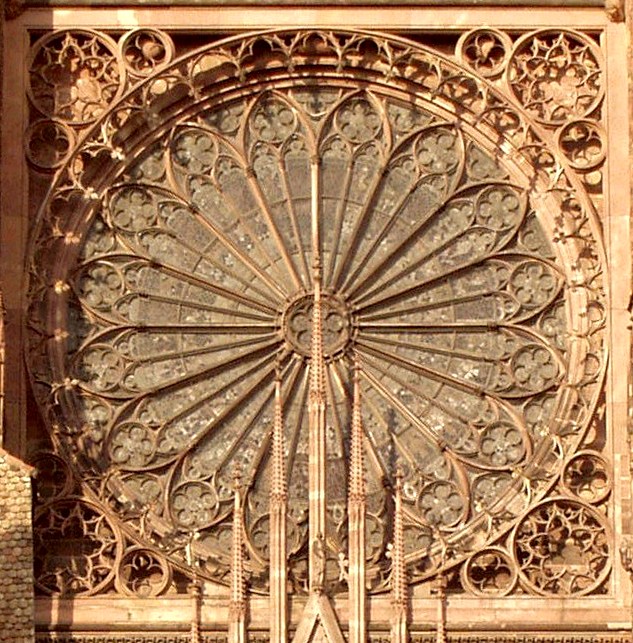|
Calvary Presbyterian Church (Milwaukee)
Calvary Presbyterian Church (Calvary Church) is a Victorian Gothic church located in the Marquette University district of downtown Milwaukee, Wisconsin. It has been listed on the National Register of Historic Places since 1986. The first Presbyterian congregation in Milwaukee was started by Reverend Cutting Marsh in 1837, and eventually became First Presbyterian. In 1849 North Presbyterian split off. In 1869, the Presbyterians on the west side wanted their own church, and some left each of the previous congregations to form Calvary. Calvary's first officers were John Plankinton, James B. Bradford, and Samuel C. West - all wealthy businessmen. They built their grand church in 1870, designed by Milwaukee architects Henry C. Koch and Julius Hess in Gothic Revival style. It sits on a foundation of ashlar limestone. The body of the structure is cream city brick, a light-colored brick kilned from local clay, with accents of Ohio sandstone. The exterior has since been pain ... [...More Info...] [...Related Items...] OR: [Wikipedia] [Google] [Baidu] |
Marquette Interchange
The Marquette Interchange is a major freeway interchange in downtown Milwaukee, Wisconsin, located near Marquette University where Interstate 43 (I-43, North–South Freeway), I-94 (North–South Freeway and East–West Freeway), and I-794 (Lake Freeway) meet. Originally built in the 1960s, the interchange underwent a total rebuild between 2004 and 2008, and was officially opened on August 19, 2008, after what was at the time the largest construction project in state history. During the early 2000s, U.S. Highway 41 (US 41) had followed I-94 through the interchange. This had changed when I-41 was designated in the Milwaukee area. US 41 now follows I-41 through the Zoo Interchange instead. History The history of the Marquette Interchange, originally called the Central Interchange, stretches back more than half a century. The idea of a north–south freeway with an interchange in downtown Milwaukee was first proposed in 1952 for an area south and east of Marquette Universit ... [...More Info...] [...Related Items...] OR: [Wikipedia] [Google] [Baidu] |
Slate
Slate is a fine-grained, foliated, homogeneous metamorphic rock derived from an original shale-type sedimentary rock composed of clay or volcanic ash through low-grade regional metamorphism. It is the finest grained foliated metamorphic rock. Foliation may not correspond to the original sedimentary layering, but instead is in planes perpendicular to the direction of metamorphic compression. The foliation in slate is called " slaty cleavage". It is caused by strong compression causing fine grained clay flakes to regrow in planes perpendicular to the compression. When expertly "cut" by striking parallel to the foliation, with a specialized tool in the quarry, many slates will display a property called fissility, forming smooth flat sheets of stone which have long been used for roofing, floor tiles, and other purposes. Slate is frequently grey in color, especially when seen, en masse, covering roofs. However, slate occurs in a variety of colors even from a single locality; f ... [...More Info...] [...Related Items...] OR: [Wikipedia] [Google] [Baidu] |
Churches In Milwaukee
Church may refer to: Religion * Church (building), a building for Christian religious activities * Church (congregation), a local congregation of a Christian denomination * Church service, a formalized period of Christian communal worship * Christian denomination, a Christian organization with distinct doctrine and practice * Christian Church, either the collective body of all Christian believers, or early Christianity Places United Kingdom * Church (Liverpool ward), a Liverpool City Council ward * Church (Reading ward), a Reading Borough Council ward * Church (Sefton ward), a Metropolitan Borough of Sefton ward * Church, Lancashire, England United States * Church, Iowa, an unincorporated community * Church Lake, a lake in Minnesota Arts, entertainment, and media * ''Church magazine'', a pastoral theology magazine published by the National Pastoral Life Center Fictional entities * Church (''Red vs. Blue''), a fictional character in the video web series ''Red vs. Blue'' ... [...More Info...] [...Related Items...] OR: [Wikipedia] [Google] [Baidu] |
Churches On The National Register Of Historic Places In Wisconsin
Church may refer to: Religion * Church (building), a building for Christian religious activities * Church (congregation), a local congregation of a Christian denomination * Church service, a formalized period of Christian communal worship * Christian denomination, a Christian organization with distinct doctrine and practice * Christian Church, either the collective body of all Christian believers, or early Christianity Places United Kingdom * Church (Liverpool ward), a Liverpool City Council ward * Church (Reading ward), a Reading Borough Council ward * Church (Sefton ward), a Metropolitan Borough of Sefton ward * Church, Lancashire, England United States * Church, Iowa, an unincorporated community * Church Lake, a lake in Minnesota Arts, entertainment, and media * ''Church magazine'', a pastoral theology magazine published by the National Pastoral Life Center Fictional entities * Church (''Red vs. Blue''), a fictional character in the video web series ''Red vs. Blue'' * ... [...More Info...] [...Related Items...] OR: [Wikipedia] [Google] [Baidu] |
American Civil War
The American Civil War (April 12, 1861 – May 26, 1865; also known by other names) was a civil war in the United States. It was fought between the Union ("the North") and the Confederacy ("the South"), the latter formed by states that had seceded. The central cause of the war was the dispute over whether slavery would be permitted to expand into the western territories, leading to more slave states, or be prevented from doing so, which was widely believed would place slavery on a course of ultimate extinction. Decades of political controversy over slavery were brought to a head by the victory in the 1860 U.S. presidential election of Abraham Lincoln, who opposed slavery's expansion into the west. An initial seven southern slave states responded to Lincoln's victory by seceding from the United States and, in 1861, forming the Confederacy. The Confederacy seized U.S. forts and other federal assets within their borders. Led by Confederate President Jefferson ... [...More Info...] [...Related Items...] OR: [Wikipedia] [Google] [Baidu] |
Wisconsin Historical Society
The Wisconsin Historical Society (officially the State Historical Society of Wisconsin) is simultaneously a state agency and a private membership organization whose purpose is to maintain, promote and spread knowledge relating to the history of North America, with an emphasis on the state of Wisconsin and the trans-Allegheny West. Founded in 1846 and chartered in 1853, it is the oldest historical society in the United States to receive continuous public funding. The society's headquarters are located in Madison, Wisconsin, on the campus of the University of Wisconsin–Madison. __TOC__ Organization The Wisconsin Historical Society is organized into four divisions: the Division of Library-Archives, the Division of Museums and Historic Sites, the Division of Historic Preservation-Public History, and the Division of Administrative Services. Division of Library, Archives, and Museum Collections The Division of Library-Archives collects and maintains books and documents abou ... [...More Info...] [...Related Items...] OR: [Wikipedia] [Google] [Baidu] |
Chartres, France
Chartres () is the Prefectures in France, prefecture of the Eure-et-Loir Departments of France, department in the Centre-Val de Loire Regions of France, region in France. It is located about southwest of Paris. At the 2019 census, there were 170,763 inhabitants in the Functional area (France), metropolitan area of Chartres (as defined by the Institut national de la statistique et des études économiques, INSEE), 38,534 of whom lived in the city (Communes of France, commune) of Chartres proper. Chartres is famous worldwide for its Chartres Cathedral, cathedral. Mostly constructed between 1193 and 1250, this Gothic architecture, Gothic cathedral is in an exceptional state of preservation. The majority of the original stained glass windows survive intact, while the architecture has seen only minor changes since the early 13th century. Part of the old town, including most of the library associated with the School of Chartres, was destroyed by Allies of World War II, Allied bombs i ... [...More Info...] [...Related Items...] OR: [Wikipedia] [Google] [Baidu] |
Cathedral Of Chartres
Chartres Cathedral, also known as the Cathedral of Our Lady of Chartres (french: Cathédrale Notre-Dame de Chartres), is a Roman Catholic church in Chartres, France, about southwest of Paris, and is the seat of the Bishop of Chartres. Mostly constructed between 1194 and 1220, it stands on the site of at least five cathedrals that have occupied the site since the Diocese of Chartres was formed as an episcopal see in the 4th century. It is in the High Gothic and Romanesque styles, with a Flamboyant north spire. The cathedral was designated a World Heritage Site by UNESCO in 1979, which called it "the high point of French Gothic art" and a "masterpiece". The cathedral is well-preserved and well-restored: the majority of the original stained glass windows survive intact, while the architecture has seen only minor changes since the early 13th century. The building's exterior is dominated by heavy flying buttresses which allowed the architects to increase the window size significant ... [...More Info...] [...Related Items...] OR: [Wikipedia] [Google] [Baidu] |
Prayer Labyrinth
In Greek mythology, the Labyrinth (, ) was an elaborate, confusing structure designed and built by the legendary artificer Daedalus for King Minos of Crete at Knossos. Its function was to hold the Minotaur, the monster eventually killed by the hero Theseus. Daedalus had so cunningly made the Labyrinth that he could barely escape it after he built it. Although early Cretan coins occasionally exhibit branching (multicursal) patterns, the single-path (unicursal) seven-course "Classical" design without branching or dead ends became associated with the Labyrinth on coins as early as 430 BC, and similar non-branching patterns became widely used as visual representations of the Labyrinth – even though both logic and literary descriptions make it clear that the Minotaur was trapped in a complex branching maze. Even as the designs became more elaborate, visual depictions of the mythological Labyrinth from Roman times until the Renaissance are almost invariably unicursal. Branching ma ... [...More Info...] [...Related Items...] OR: [Wikipedia] [Google] [Baidu] |
Nave
The nave () is the central part of a church, stretching from the (normally western) main entrance or rear wall, to the transepts, or in a church without transepts, to the chancel. When a church contains side aisles, as in a basilica-type building, the strict definition of the term "nave" is restricted to the central aisle. In a broader, more colloquial sense, the nave includes all areas available for the lay worshippers, including the side-aisles and transepts.Cram, Ralph Adams Nave The Catholic Encyclopedia. Vol. 10. New York: Robert Appleton Company, 1911. Accessed 13 July 2018 Either way, the nave is distinct from the area reserved for the choir and clergy. Description The nave extends from the entry—which may have a separate vestibule (the narthex)—to the chancel and may be flanked by lower side-aisles separated from the nave by an arcade. If the aisles are high and of a width comparable to the central nave, the structure is sometimes said to have three nave ... [...More Info...] [...Related Items...] OR: [Wikipedia] [Google] [Baidu] |
Rose Window
Rose window is often used as a generic term applied to a circular window, but is especially used for those found in Gothic cathedrals and churches. The windows are divided into segments by stone mullions and tracery. The term ''rose window'' was not used before the 17th century and comes from the English flower name rose. The name "wheel window" is often applied to a window divided by simple spokes radiating from a central boss or opening, while the term "rose window" is reserved for those windows, sometimes of a highly complex design, which can be seen to bear similarity to a multi-petalled rose. Rose windows are also called "Catherine windows" after Saint Catherine of Alexandria, who was sentenced to be executed on a spiked breaking wheel. A circular window without tracery such as are found in many Italian churches, is referred to as an ocular window or oculus. Rose windows are particularly characteristic of Gothic architecture and may be seen in all the major Gothic C ... [...More Info...] [...Related Items...] OR: [Wikipedia] [Google] [Baidu] |







